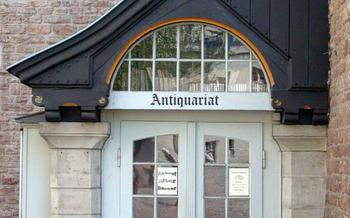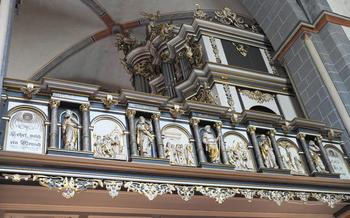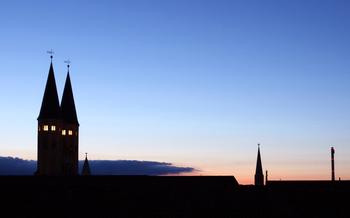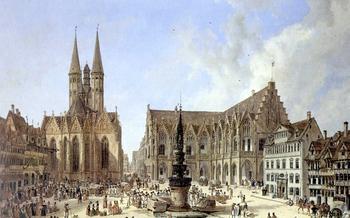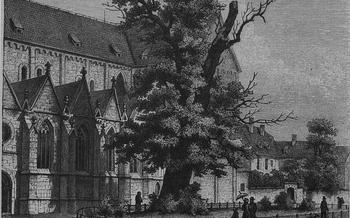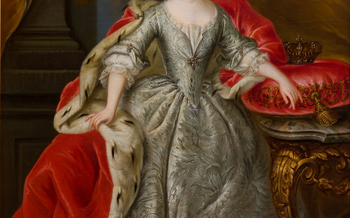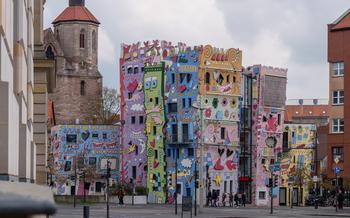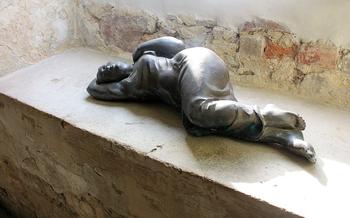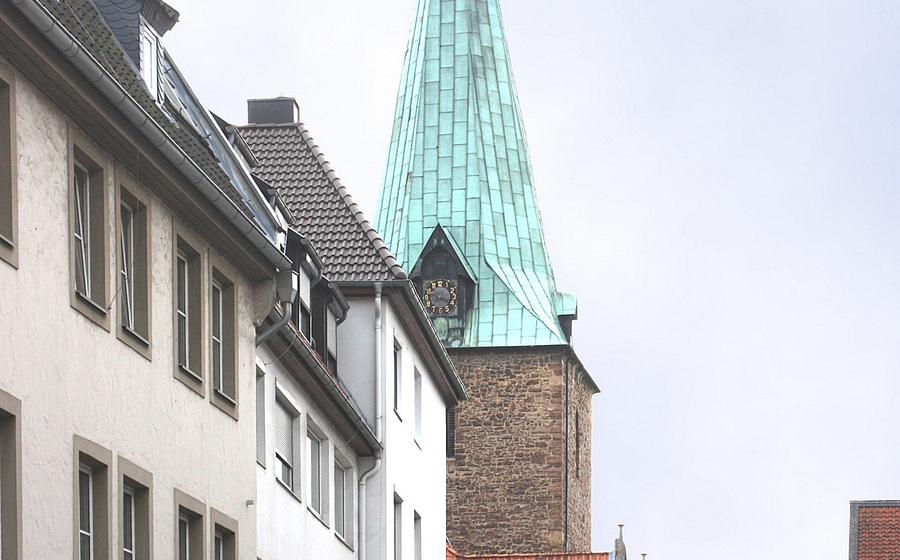
St. Michaelis Church
- A City of History and Culture
- The St. Michaelis Church - A Gothic Masterpiece
- Exploring the Church's Interior
- A Symbol of Faith and Community
- Views from the Steeple
- The Legend of the Seven Towers
- The Stone Lions
- The Crypt and Tombs
- The Glockenspiel: A Melodic Masterpiece
- Guided Tours and Events
- Practical Information
- Nearby Attractions
- Accommodation and Dining
- Planning Your Visit
- Insider Tip: A Hidden Gem and a Unique Perspective
A City of History and Culture
Braunschweig, a city steeped in history and brimming with cultural allure, is located in the heart of Lower Saxony, Germany. Founded by Henry the Lion in the 12th century, Braunschweig rapidly rose to prominence as a trading hub and a center of learning. Its rich architectural heritage is a testament to its storied past, with magnificent buildings such as the Dankwarderode Castle, the Old Town Hall, and the Cathedral of St. Blasius gracing its cityscape. The city's cultural vibrancy is further enhanced by a multitude of events and festivals, including the Braunschweig Classical Music Festival, the International Film Festival Braunschweig, and the Braunschweig Christmas Market, which attract visitors from far and wide.
The St. Michaelis Church - A Gothic Masterpiece
The St. Michaelis Church, a magnificent example of Gothic architecture, stands as a testament to the rich history and cultural heritage of Braunschweig. Constructed between 1250 and 1416, the church boasts an impressive blend of architectural styles, from the Romanesque foundations to the Gothic additions. Its distinctive silhouette, dominated by the towering spire, has become an iconic landmark of the city's skyline.
The church's exterior is adorned with intricate carvings and sculptures, showcasing the skill and artistry of medieval craftsmen. The main portal, known as the "Golden Gate," features a series of biblical scenes depicted in stone, while the choir's exterior is adorned with delicate tracery and finials. The towering spire, a symbol of Braunschweig's prosperity and power, reaches a height of 91 meters and offers breathtaking panoramic views of the city.
Exploring the Church's Interior
Venturing inside the St. Michaelis Church is like stepping into a realm of awe and inspiration. The intricate altarpieces, stunning stained-glass windows, and impressive organ create a symphony of art and devotion.
The high altar, a masterpiece of Gothic craftsmanship, captivates the eye with its intricate carvings and vibrant colors. Depicting scenes from the life of Christ, the altar narrates the sacred story with exquisite detail.
The stained-glass windows, a kaleidoscope of hues, bathe the church interior in a celestial glow. Each window tells a biblical tale, casting a radiant light that illuminates the grandeur of the space.
The organ, a testament to German musical prowess, fills the church with its majestic sound. With its imposing pipes and intricate carvings, the organ is not just an instrument, but a work of art in its own right.
A Symbol of Faith and Community
The St. Michaelis Church has played a significant role in the religious and social life of Braunschweig throughout history. As the primary place of worship for the local Lutheran community, it has witnessed countless baptisms, weddings, funerals, and other religious ceremonies. The church has also been a gathering place for the community, hosting events such as concerts, lectures, and charity functions. Over the centuries, the church has become deeply intertwined with the identity and heritage of Braunschweig, serving as a symbol of faith, community, and cultural continuity.
The church has been the site of many important religious events and celebrations. For instance, during the annual Braunschweig Christmas Market, the church hosts special services and concerts that attract visitors from all over the region. The church is also a popular venue for weddings, with many couples choosing to exchange vows in its beautiful and historic surroundings.
Beyond its religious significance, the St. Michaelis Church has also been a venue for cultural and historical events. In the 19th century, the church hosted lectures by renowned philosophers and scientists such as Georg Wilhelm Friedrich Hegel and Alexander von Humboldt. The church has also been used for political rallies and demonstrations, reflecting its role as a public gathering place.
Views from the Steeple
Ascending the steeple of St. Michaelis Church is a must for those seeking a breathtaking panorama of Braunschweig and its surroundings. The 46-meter-high tower offers a unique perspective, allowing visitors to appreciate the city's layout, landmarks, and the rolling countryside beyond.
The steeple's observation deck provides unobstructed views in all directions, making it an ideal spot for photography enthusiasts. Capture the city's skyline dominated by the spires of other historic churches, the sprawling greenery of parks and gardens, and the distant Harz Mountains.
The steeple's historical significance adds to the experience. It once served as a watchtower, with guards keeping a lookout for approaching enemies or fires. Visitors can imagine the medieval sentries scanning the horizon, protecting the city from danger.
Taking in the views from the steeple is a memorable experience that offers a deeper appreciation for Braunschweig's rich history and vibrant present.
The Legend of the Seven Towers
Folklore and local legends are deeply intertwined with the St. Michaelis Church, and one of the most intriguing tales is that of the Seven Towers. According to the legend, the church was originally intended to have seven towers, representing the seven days of the week. However, due to a lack of funds, only five towers were completed. The incomplete towers are said to symbolize the incompleteness of human endeavors and the eternal striving for perfection.
The symbolism of the seven towers is further enriched by their association with the seven hills of Rome, which are believed to represent the seven deadly sins. The incomplete towers, therefore, serve as a reminder of the human struggle against temptation and the need for spiritual growth and redemption.
The legend of the Seven Towers has become an integral part of Braunschweig's cultural heritage, passed down through generations through storytelling and local traditions. It adds a layer of mystery and intrigue to the St. Michaelis Church, inviting visitors to ponder the deeper meanings behind its architectural features.
The Stone Lions
Cultural Significance and Folklore
The stone lions that flank the entrance to the St. Michaelis Church are not just decorative elements but also hold deep cultural significance and are steeped in local folklore. These majestic creatures, with their fierce expressions and imposing presence, have become iconic symbols of the church and the city of Braunschweig.
The lions are believed to represent strength, courage, and protection. In many cultures, lions are associated with royalty and power, and their presence at the entrance to the church suggests that it is a place of importance and authority. The lions are also seen as guardians, protecting the church and its congregation from harm.
Folklore surrounding the lions is rich and varied. One legend tells of a time when the city was under attack, and the lions came to life to defend it. They roared fiercely and charged at the enemy, driving them away and saving the city. Another legend claims that the lions have the power to grant wishes. If a person whispers their wish into the lion's ear, it will come true.
Whether these legends are true or not, the stone lions have become an integral part of the St. Michaelis Church and the city of Braunschweig. They are a reminder of the church's long history and its importance to the local community. They are also a symbol of the city's strength and resilience, and a source of pride for its citizens.
The Crypt and Tombs
Beneath the St. Michaelis Church lies a hidden realm of history and reverence – the crypt and tombs. This sacred space is the resting place of notable figures from Braunschweig's past, their stories intertwined with the church's rich tapestry. Among them lies Henry the Lion, Duke of Saxony and Bavaria, a legendary figure who played a pivotal role in shaping the city's destiny. His imposing tomb, adorned with intricate carvings and effigies, stands as a testament to his legacy.
The crypt's atmospheric chambers house a collection of sarcophagi, each bearing the mark of time and the weight of history. Here, visitors can pay their respects to prominent citizens, religious leaders, and benefactors who contributed to Braunschweig's growth and prosperity. The tombs, some adorned with elaborate sculptures and inscriptions, offer a glimpse into the lives and achievements of these individuals.
Beyond its historical significance, the crypt possesses an air of tranquility and reverence. Its dimly lit corridors and hushed atmosphere invite visitors to reflect on the passage of time and the enduring legacy of those who have gone before. Whether seeking a moment of contemplation or delving into the depths of Braunschweig's history, the crypt offers a unique and immersive experience.
The Glockenspiel: A Melodic Masterpiece
The St. Michaelis Church is not just a religious site but also a hub of musical excellence. One of its most captivating features is the glockenspiel, a mechanical musical instrument consisting of a set of bells. The glockenspiel in the St. Michaelis Church is renowned for its intricate craftsmanship and enchanting melodies.
History and Construction: The glockenspiel was constructed in the 17th century, coinciding with the Baroque period when such instruments were gaining popularity. It was meticulously crafted by skilled artisans who poured their passion and precision into its creation. The intricate mechanisms and delicate bells were designed to produce a harmonious and enchanting sound.
Musical Repertoire and Performances: The glockenspiel boasts a diverse repertoire of melodies, from classical compositions to traditional folk tunes. Every hour, the bells chime to serenade visitors with a delightful mix of music. The enchanting melodies echo through the church's grand interior, creating a captivating atmosphere that transports listeners to a bygone era.
Cultural and Historical Significance: The glockenspiel is not merely a musical instrument but also a significant cultural artifact. It represents the rich musical heritage of the region and has become an integral part of the church's identity. Throughout history, the glockenspiel has played a crucial role in marking important occasions, festivals, and religious ceremonies. It serves as a poignant reminder of the enduring power of music to transcend time and inspire generations.
Guided Tours and Events
Guided tours of the St. Michaelis Church are available throughout the year, providing visitors with an in-depth look at its history, architecture, and unique features. Knowledgeable guides lead these tours, sharing fascinating stories and insights about the church. Visitors can also book private tours for a more personalized experience.
The church regularly hosts special events and concerts. These events often feature renowned musicians and performers, showcasing the church's impressive acoustics. Visitors can enjoy classical concerts, organ recitals, and seasonal performances that bring the church's history and grandeur to life.
Educational programs and workshops are also offered at the St. Michaelis Church, providing opportunities for visitors of all ages to learn more about the church's history, architecture, and religious significance. These programs often include hands-on activities and interactive sessions, making them a great way for families and groups to engage with the church's rich heritage.
Practical Information
Location and accessibility
The St. Michaelis Church is conveniently located in the heart of Braunschweig, on Michaelisplatz. It is easily accessible by foot or public transportation. The closest tram stop is "Wendenstraße," and several bus lines also stop nearby. For those arriving by car, there are limited parking options in the surrounding streets, but it is advisable to use public parking garages or consider walking or biking to reduce traffic congestion in the city center.
Opening hours and admission fees
The church is open to the public during specific hours, typically from 10 am to 5 pm on weekdays and 12 pm to 5 pm on Sundays. Admission to the church is free of charge, allowing visitors to explore its interior and admire its stunning architecture, artwork, and historical artifacts. However, guided tours, which offer a more in-depth understanding of the church's history and significance, may require a small fee.
Contact information and website
For more information about the St. Michaelis Church, guided tours, events, and accessibility, visitors can contact the church office by phone at +49 (0)531 4701521 or via email at [email protected]. Additionally, the church has an informative website at www.michaeliskirche-braunschweig.de, where visitors can find details about its history, upcoming events, and practical information.
Nearby Attractions
Braunschweig offers a wealth of historical sites, cultural institutions, and shopping and dining options within easy reach of the St. Michaelis Church. Visitors can explore the historic Altstadt (Old Town), home to the magnificent Braunschweig Cathedral, the Dankwarderode Castle, and the Altstadtmarkt, a vibrant square lined with colorful half-timbered houses.
For those interested in art and history, the Herzog Anton Ulrich Museum is a must-visit, showcasing an impressive collection of paintings, sculptures, and artifacts from the Middle Ages to the present day. The Städtisches Museum Braunschweig, housed in a former monastery, offers insights into the city's rich history and culture through interactive exhibits and displays.
Braunschweig is also known for its vibrant shopping scene, with a mix of traditional German shops, international brands, and charming boutiques. Visitors can stroll along the charming shopping streets of Bohlweg and Sack, where they can find everything from souvenirs and handicrafts to designer clothing and accessories.
After a day of sightseeing and shopping, visitors can indulge in Braunschweig's culinary delights. The city offers a diverse range of restaurants, from traditional German taverns serving hearty local specialties to international cuisine from around the world. Be sure to sample some of the region's specialties, such as the Brunswick sausage, the Braunschweiger Mumme beer, and the delicious Baumkuchen, a traditional German cake.
Accommodation and Dining
Braunschweig offers a range of accommodation options to suit every budget and preference. From cozy guesthouses and budget-friendly hostels to elegant hotels and luxurious resorts, there's something for everyone. For a truly immersive experience, consider staying in a traditional half-timbered house, a staple of Braunschweig's architectural heritage.
When it comes to dining, Braunschweig's culinary scene is as diverse as its history. From traditional German fare to international cuisine, there's something to satisfy every palate. Don't miss the chance to try local specialties like the Braunschweiger Mumme, a dark beer brewed according to an ancient recipe, or the Braunschweiger Spargel, a succulent white asparagus dish.
To save money, consider taking advantage of the many food markets and street food stalls that offer delicious and affordable options. For a unique dining experience, head to the Braunschweig Christmas Market, where you can indulge in festive treats and soak up the magical atmosphere.
Planning Your Visit
The best time to visit Braunschweig and the St. Michaelis Church is during the summer months, from May to September, when the weather is pleasant, and the city is bustling with activity. To avoid crowds, it's advisable to visit on a weekday morning or during the shoulder seasons (spring or autumn). When packing for your visit, be sure to include comfortable walking shoes, as you'll likely be doing a fair amount of exploring on foot. Dress respectfully when visiting the church, as it is an active place of worship.
Here's an insider's tip: For a unique perspective of the church, climb to the top of the steeple for panoramic views of Braunschweig's skyline. While you're there, keep an eye out for the seven towers, which are a prominent feature of the cityscape and hold a special significance in local folklore.
Insider Tip: A Hidden Gem and a Unique Perspective
Beyond the awe-inspiring interior and architectural wonders, St. Michaelis Church holds a secret spot that offers a unique perspective of the city. Ascend the narrow, spiral staircase tucked away in one of the church's towers. This hidden gem, accessible through guided tours, leads you to a secluded platform nestled amidst the church's intricate spires. From this vantage point, you'll be greeted with a breathtaking panorama of Braunschweig's skyline, a mesmerizing tapestry of red-tiled roofs, Gothic spires, and the meandering Oker River. This secret spot provides a rare opportunity to capture the essence of Braunschweig's architectural heritage and the charm of its vibrant cityscape.
